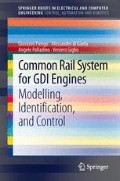Abstract
The Internal Combustion Engine (ICE) is the technological innovation that has changed the world. It is considered both as one of the greater sources of benefits and one of the main reasons of the atmospheric pollution. Therefore, in order to satisfy polluting emission legislations with particular attention for CO2 production, the engine design has been continuously improved and new components have been introduced, such as sensors and complete subsystems. The generation of polluting substances produced by the combustion depends not only on the engine structure, but also on the engine management system that is mainly responsible for the engine behavior, and so for the emission levels. Because of the introduction of new electronic components, which determines a strong increase of the degrees of freedom available during the engine operations, the optimization of engine behavior becomes more complex and less intuitive thus not obtaining the best performances of the system. Nowadays, the engine control system is an enormous collection of tuning tables, obtained adding the new tables related to new electronic components to the previous ones. This control structure is usually defined using trial-and-error approaches: engineers dedicated to the calibration process transform the goals, such as fuel consumption, engine emission, performances of the vehicle, and so on, in control references to be followed by some engine and vehicle variables that can be measured on-line. These goals are obtained through proper closed-loop control strategies receiving measurements by sensors and acting on actuators. In this chapter after a short description of the operating principles of reciprocating ICEs and their classification, an overview of a functional architecture of an Engine Management System (EMS) is given.
Access this chapter
Tax calculation will be finalised at checkout
Purchases are for personal use only
References
J.B. Heywood, Internal Combustion Engine Fundamentals (McGraw-Hill, New York, 1988)
C. Hirsch, Numerical Computation of Internal and External Flows—Fundamentals of Numerical Discretization. Wiley Series in Numerical Methods in Engineering, vol. 1. (Wiley, New York, (1997). ISBN 0-471-92385-0
C. Hirsch, Numerical Computation of Internal and External Flows—Computational Methods for Inviscid and Viscous Flows. Wiley Series in Numerical Methods in Engineering, vol. 2 (Wiley, New York, 1998). ISBN 0-471-92452-0
D.E. Winterbone, R.J. Pearson, Theory of Engine Manifold Design: Wave Action Methods for IC Engines (Wiley, New York, 2005). ISBN 978-1860582097
C. Stan, Direct Injection Systems for Spark-Ignition and Compression-Ignition Engines (SAE International, Warrendale, 1999)
F. Zhao, D.L. Harrington, M.C.D. Lai, Automotive Gasoline Direct-Injection Engines (SAE International, Warrendale, 2002). ISBN 978-0768008821
J.W. Oh, C.W. Park, H.S. Kim, G.B. Cho, Effect of multiple injection on the performance and emission characteristics of lean burn gasoline direct injection engines. Trans. Korean Soc. Mech. Eng. B 36(2), 137–143 (2012)
M. Fry, J. King, C. White, A comparison of gasoline direct injection systems and discussion of development techniques. SAE Technical Paper (no. 1999-01-0171) (1999). doi:10.4271/1999-01-0171
G. Stumpp, M.J. Ricco, Common rail—an attractive fuel injection system for passenger car DI diesel engines. SAE Technical Paper (no. 960870) (1996). doi:10.4271/960870
O. Chiavola, P. Giulianelli, Modeling and simulation of common rail systems. SAE Technical Paper (no. 2001-01-3183) (2001). doi:10.4271/2001-01-3183
H. Tomishima, T. Matsumoto, M. Oki, K. Nagata, The advanced diesel common rail system for achieving a good balance between ecology and economy. SAE Tecnical Paper (no. 2008-28-0017) (2008). doi:10.4271/2008-28-0017
W.W. Pulkrabek, Engineering Fundamentals of the Internal Combustion Engine, 2nd edn. (Prentice Hall, Upper Saddle River, 2004). ISBN 0131405705
K. Epping, S. Aceves, R. Bechtold, J. Dec, The potential of HCCI combustion for high efficiency and low emissions. SAE Technical Paper (2002-01-1923) (2002). doi:10.4271/2002-01-1923
S. Onishi, S.H. Jo, K. Shoda, P.D. Jo, S. Katof, Active thermo-atmosphere combustion (ATAC): a new combustion process for internal combustion engines. SAE Technical Paper (no. 790501) (1979). doi:10.4271/790501
M. Noguchi, Y. Tanaka, T. Tanaka, Y. Takeuchi, A study on gasoline engine combustion by observation of intermediate reactive products during combustion. SAE Technical Paper (no. 790840) (1979). doi:10.4271/790840
P. Najt, D. Fosterì, Compression-ignited homogeneous charge combustion. SAE Technical Paper (no. 830264) (1983). doi:10.4271/830264
R.H. Thring, Homogeneous-charge compression-ignition (HCCI) engines. SAE Tecnical Paper (no. 892068) (1989). doi:10.4271/892068
P. Mehresha, J. Soudera, D. Flowersb, U. Riedelc, R.W. Dibblea, Combustion timing in HCCI engines determined by ion-sensor: experimental and kinetic modeling. Proc. Combust. Inst. 30(2), 2701–2709 (2005). doi:10.1016/j.proci.2004.08.135
Y. Huang, D. Mehta, Investigation of an in-cylinder ion sensing assisted HCCI control strategy. SAE Technical Paper (no. 2005-01-0068) (2005). doi:10.4271/2005-01-0068
B. Gunston, World Encyclopedia of Aero Engines (Patrick Stephens, Cambridge, 1989). ISBN 1-85260-163-9
J. Gerhardt, H. Hönninger, H. Bischof, A new approach to functional and software structure for engine management systems—BOSCH ME7. SAE Technical Paper (no. 980801) (1998). doi:10.4271/980801
Author information
Authors and Affiliations
Corresponding author
Rights and permissions
Copyright information
© 2013 The Author(s)
About this chapter
Cite this chapter
Fiengo, G., di Gaeta, A., Palladino, A., Giglio, V. (2013). Introduction to Internal Combustion Engines. In: Common Rail System for GDI Engines. SpringerBriefs in Electrical and Computer Engineering(). Springer, London. https://doi.org/10.1007/978-1-4471-4468-7_1
Download citation
DOI: https://doi.org/10.1007/978-1-4471-4468-7_1
Published:
Publisher Name: Springer, London
Print ISBN: 978-1-4471-4467-0
Online ISBN: 978-1-4471-4468-7
eBook Packages: EngineeringEngineering (R0)

